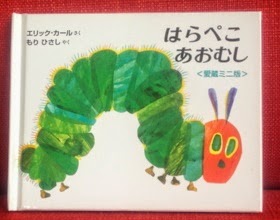
Further to my April post http://cbcatas.blogspot.com.au/2014_04_01_archive.html,
the foreign language picture book collection has grown since a recent journey
to Japan. Always with an eye open for
popular children’s books in foreign languages, Japanese book shops did not
disappoint – but Spot was harder to find.
 My forays were based in Tokyo and my first
bookshop browse found numerous popular English language titles. The most
notable: The Giving Tree and The Very Hungry Caterpillar. But not one
Spot book could I spot. Loath to go
away without one Japanese title, a mini version of Eric Carle’s greedy
caterpillar was purchased and easily stowed.
My forays were based in Tokyo and my first
bookshop browse found numerous popular English language titles. The most
notable: The Giving Tree and The Very Hungry Caterpillar. But not one
Spot book could I spot. Loath to go
away without one Japanese title, a mini version of Eric Carle’s greedy
caterpillar was purchased and easily stowed.
But now I was on a mission and that night
logged into the trusty iPad and searched for the largest Japanese bookshop I
know – Kinokuniya. And found it! In Tokyo! Just a few train lines and subway
stops away.
Kinokuniya is 6 storeys high, with each
floor focusing on a particular genre of book. Naturally, signage is in Japanese
and helpful shop assistants kept directing us to the foreign language floor. In
the end we caught the elevator to the 6th floor and worked our way
down. And on the 4th floor we found the children’s department. Joy J
 There were a few challenges. There were
many, many books – shelves of them – most with only their spines showing. We
scouted around until we located a large section of translated books. There were
The Giving Tree and the Very Hungry Caterpillar, and the
recent rerelease of The 3 Robbers amongst many others. But no
sign of Spot. A young non-English
speaking shop assistant came to help.
With some dramatic dog like actions, tail wagging and ‘woof woofing’ (wondering if dogs said ‘woof’ in Japanese) the
light dawned and she took us to the non-fiction pet books. We took her back to
the translated section and tried a different tack. I picked up The 3 Robbers and without being able to
read a word of Japanese, correctly identified the author’s name on the cover.
The sales assistant said “Tomi Ungerer’ with a delightful accent. I then wrote
down ‘Eric Hill’ on her notepad, ‘woofed’ and she laughed. A light bulb moment.
Off to a senior sales person, a computer search, and back she came, straight to
the shelves, flicked through the spines and pulled out two Spot books.
There were a few challenges. There were
many, many books – shelves of them – most with only their spines showing. We
scouted around until we located a large section of translated books. There were
The Giving Tree and the Very Hungry Caterpillar, and the
recent rerelease of The 3 Robbers amongst many others. But no
sign of Spot. A young non-English
speaking shop assistant came to help.
With some dramatic dog like actions, tail wagging and ‘woof woofing’ (wondering if dogs said ‘woof’ in Japanese) the
light dawned and she took us to the non-fiction pet books. We took her back to
the translated section and tried a different tack. I picked up The 3 Robbers and without being able to
read a word of Japanese, correctly identified the author’s name on the cover.
The sales assistant said “Tomi Ungerer’ with a delightful accent. I then wrote
down ‘Eric Hill’ on her notepad, ‘woofed’ and she laughed. A light bulb moment.
Off to a senior sales person, a computer search, and back she came, straight to
the shelves, flicked through the spines and pulled out two Spot books.
And yes, I bought both. I have added
Japanese versions of Where’s Spot and
Who’s There Spot? to the collection. A
successful, and hilarious, day’s shopping. And as a matter of interest, both
books were in hardback and were priced at around $12 each. Books in Japan are
affordable and highly valued.
Jennie Bales






